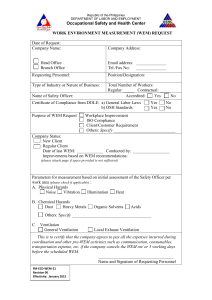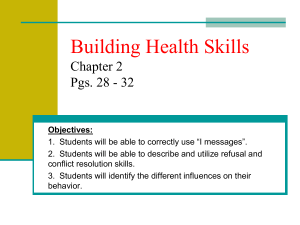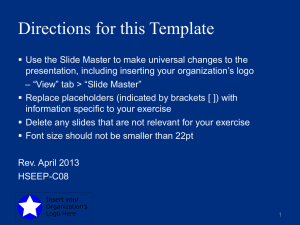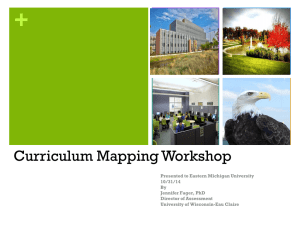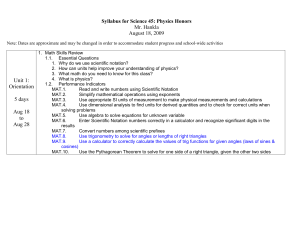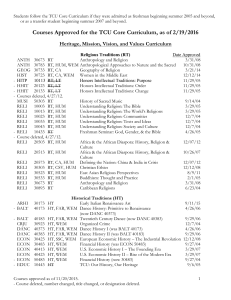Retention of Wilderness Medicine Knowledge & Skills
advertisement
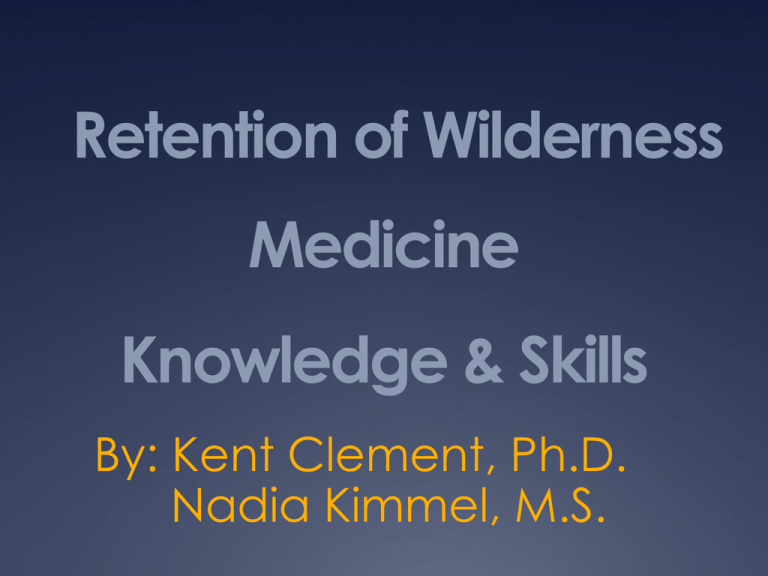
Retention of Wilderness Medicine Knowledge & Skills By: Kent Clement, Ph.D. Nadia Kimmel, M.S. Consider This Scenario SCENARIO You and your friends are hiking on a mountain trail in mid-August. You are enjoying a beautiful sunny afternoon with a temperature of 72 F. You come across a person sitting on the trail holding his/her right arm. This person is alone and there are no bystanders. You are 5 miles from the nearest trailhead where your vehicle is parked. It is ten miles from the trailhead to the nearest town. There is no cell reception until you reach the town limits. Based on your WFR knowledge and skills what are some of the things that you should do? SCENE SIZE – UP & INITIAL ASSESSMENT After determining that the scene is safe, you find out the person’s name but he/she does no know what happened. The person is confused and exhibits a slurred speech. They complain of pain while guarding their right arm. No sign of life threatening trauma is apparent. WHAT NEXT? SCENARIO After asking SAMPLE and taking vitals you find out the following: S: A: M: P: L: E: Pain in the right arm, pale, confused, slurred speech. None None Diabetes (Type II) Not sure Does not recall HR: RR: BP: LOC: SCTM: CSM: 132 30 Strong radial pulse A & 0 X 1 (Alert & oriented to person only) Pale, warm & dry Weak in all four extremities, can feel, does not respond to commands well but has good pulses PERRL: Normal WHAT NEXT? SCENARIO TREATMENTS Glucose administration while protecting the airway. Splint the arm and check CSM before and after. Head-to-toe exam (reveals nothing) Clear the spine while meeting all criteria Formulate an evacuation plan Average Score 44% INCOMPLETE SAMPLE INCOMPLETE VITALS NO GLUCOSE ADMINISTRATION POOR AIRWAY MANGMENT 10/23 Participants’ Demographics 34 total F-9, M-25 Age Range Age Num. 18-24 25-30 12 8 31-35 36-40 41-50 51-55 56-60 60 up 3 4 3 1 1 2 Highest WEM Certification – WFR-33, WEMT-1 Study Limitations Not generalizable as it stands due to a small sample size Not randomized design – opportunity sampling Preliminary study – You can get involved with this research – details to follow… More Demographics First Obtained WEM Certification in years ago: Years Ago 2 3 4 5 6 7 10 11 15 Num. 12 4 1 3 5 1 5 1 1 Number of Recertification Courses: ReCert 0 1 2 3 4 Num. 16 8 4 3 2 Still More Demographics The Type of Work They Currently Pursue: Guides – 19 Therapy – 1 Outward Bound – 9 Outdoor Education – 2 Volunteer Organization – 1 Conservation – 1 Field Biologist – 1 Why did you get an WEM Cert. in the 1st place? Required by job – 29, SAR – 1, Required in School - 3 Results Before the scenario, participants were asked to estimate the percentage of knowledge required to be fully-qualified as a WEM provider they have retained. Answer average: 65%, Range: 17.5 to 90. Before the scenario, participants were asked to estimate the percentage of skill required to be fully-qualified as a WEM provider they have retained. Answer average: 68%, Range: 20 to 90. Remember, accuracy was 44% More Results After the scenario, participants were asked if they retained as much knowledge required to be fully-qualified as a WEM provider as they thought they would. Answer: Yes – 7, No – 27 After the scenario, participants were asked if they retained as much skill required to be fullyqualified as a WEM provider as they thought they would. Answer: Yes – 18, No - 16 Injuries With Which Participants Dealt: ligament sprain 12 blister(s) 25 Laceration 22 immersion foot 6 muscle sprain 13 bruise, contusion 18 Sunburn 29 Tendonitis 6 Frostbite 5 head injury without loss of tooth related 5 Fracture 9 Burn 14 eye injury 5 Dislocation 5 skin abrasions 25 consciousness head injury with loss of consciousness 10 1 Injuries With Which Participants Dealt: near drowning 3 shoulder dislocation 7 life threatening bleed 0 back injury 5 “Other” includes: fish hook, fractured pelvis, sickle cell disease, ruptured spleen, compound fracture, snake bite. Illnesses With Which Participants Dealt: allergic reaction 17 urinary tract infection 4 Anaphylaxis 2 skin infection 10 Diarrhea 20 heat cramps 2 AMS 12 heat exhaustion 15 food related illness 9 heat stroke 1 HAPE 0 chest pain or cardiac cond. 2 HACE 0 eye infection 2 upper respiratory illness 2 non-spec. fever illness 4 Illnesses With Which Participants Dealt: abdominal or other gastrointestinal problem without diarrhea 12 Hyponatremia 3 dehydration 21 hypothermia illness 6 snake bites 1 heat illness 7 spider bites 6 cardiac emergencies 0 scorpions stings 3 diabetic emergencies 3 bee stings 13 Seizures 3 red/fire ant stings 5 Asthma 6 animal bites 1 behavioral emerg. 8 gender spec. issues 4 Illnesses With Which Participants Dealt: toleo (foot rot specific to the Grand Canyon) 3 ear infection 0 Cpr 2 rescue breathing 1 Other 0 Are we failing? Ideas for Improving Retention Limit rescuer distraction Simplify wilderness medicine curricula Emphasize SAMPLE and information gathering skills in wilderness medicine classes Offer continuing education classes on-line as part of the recertification process Look at other medical industry standards for recertification requirements and lengths • CPR • NREMT • ACLS • OEC More Ideas for Improving Retention Recalibrate rescuer overconfidence Design curriculum giving precedence to the activities with which rescuers are most likely to face in an emergency situation. Shorten the re-certification period. (I know, I know) Getting involved with the study:

